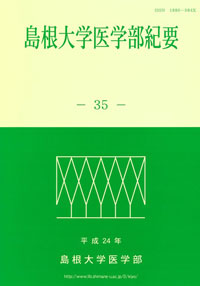島根大学医学部
ISSN:1880-084X

ダウンロード数 : ? 件
この文献の参照には次のURLをご利用ください : https://ir.lib.shimane-u.ac.jp/45524
島根大学医学部紀要 41
2019-03 発行
慢性閉塞性肺疾患をもつ高齢者と家族がCO2ナルコーシスの兆しを捉え入院に至る過程
A Process in Which Elderly With Chronic Obstructive Pulmonary Disease and a Family Member of the Elderly Caught Signs of CO2 Narcosis Leading to Hospitalization
ファイル
内容記述(抄録等)
The objective of this study was to clarify when and how elderly with chronic obstructive
pulmonary disease (COPD), who eventually became hospitalized due to CO2 narcosis, caught signs of CO2 narcosis along with a family member of the elderly. Semi-structured interviews were conducted with the elderly (Subject A) and the family member of the elderly (Subject B), and the signs captured by each subject were examined and analyzed chronologically. As a result of comparative analysis of chronological differences and characteristics of the signs captured by each subject, the signs were divided into the following phases: Phase I (a phase in which Subject A did not catch signs and Subject B began to catch signs), Phase II (a phase in which Subject A began to catch signs and there was a
perception gap between Subject A and Subject B), and Phase III (a phase in which the perceptions of the signs caught by Subject A and by Subject B matched). Both subjects not only captured the occurrences of new symptoms but also perceived how the range of activities Subject A could perform independently became smaller and smaller. The results suggest the need to focus on family members’ perception of signs captured before the affected elderly’s perception of such signs, and also on the change in the elderly who can no longer perform their daily activities as they used to, to enable the elderly to have a medical examination before their CO2 retention progresses and becomes severe.
pulmonary disease (COPD), who eventually became hospitalized due to CO2 narcosis, caught signs of CO2 narcosis along with a family member of the elderly. Semi-structured interviews were conducted with the elderly (Subject A) and the family member of the elderly (Subject B), and the signs captured by each subject were examined and analyzed chronologically. As a result of comparative analysis of chronological differences and characteristics of the signs captured by each subject, the signs were divided into the following phases: Phase I (a phase in which Subject A did not catch signs and Subject B began to catch signs), Phase II (a phase in which Subject A began to catch signs and there was a
perception gap between Subject A and Subject B), and Phase III (a phase in which the perceptions of the signs caught by Subject A and by Subject B matched). Both subjects not only captured the occurrences of new symptoms but also perceived how the range of activities Subject A could perform independently became smaller and smaller. The results suggest the need to focus on family members’ perception of signs captured before the affected elderly’s perception of such signs, and also on the change in the elderly who can no longer perform their daily activities as they used to, to enable the elderly to have a medical examination before their CO2 retention progresses and becomes severe.
本研究の目的は、CO2ナルコーシスで入院に至った慢性閉塞性肺疾患をもつ高齢者と家族が、その兆しをいつ、どのように捉えていたのかを明らかにすることとした。高齢者(A氏)と家族(B氏)に半構造化面接を行い、それぞれが捉えた兆しの時間的な順序性を考慮し整理した。両者が捉えた兆しの差異や特徴を時系列で比較検討した結果、Ⅰ期【A氏本人は兆しを捉えていないが、B氏は捉え始めた時期】、Ⅱ期【A氏が兆しを捉え始めるが、B氏が捉える兆しとの認識のずれがある時期】、Ⅲ期【A氏とB氏の捉える兆しの認識が合致している時期】に分けられた。また、両者ともに新たな症状の出現だけでなく、A氏が自分で行えていたことができにくくなる様子を捉えていた。CO2 貯留が進行し重症化する前に受診できるように、高齢者より先に兆しを捉えていた家族の気づきや、当たり前に行えていたことができにくくなる高齢者の変化に着目する必要性が示唆された。
Other Article
